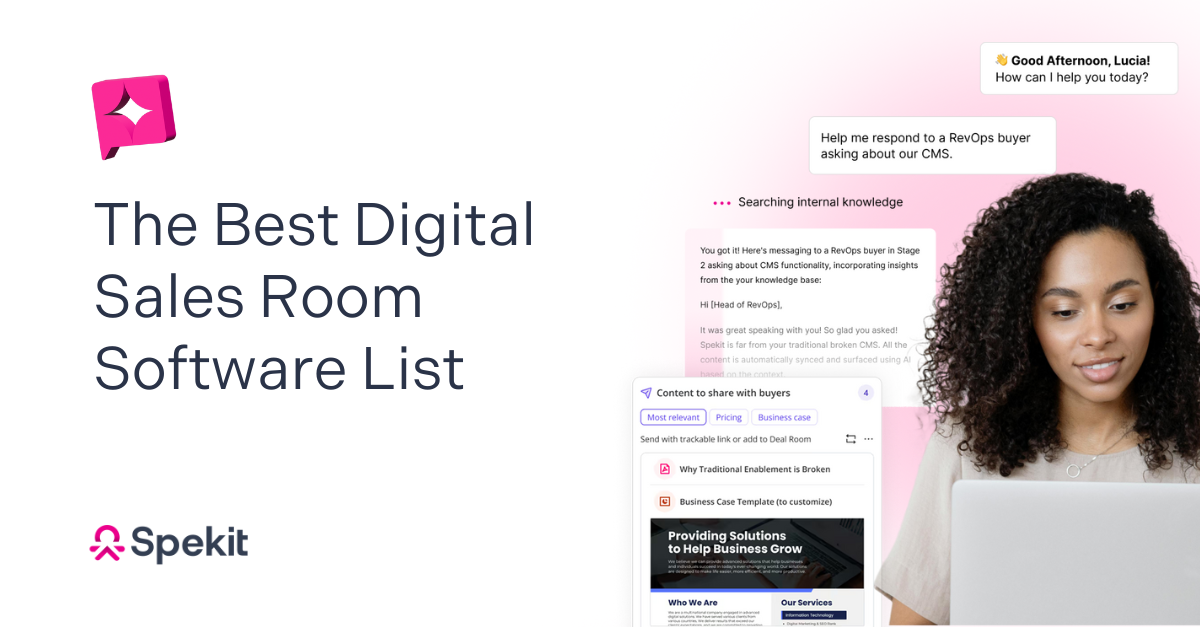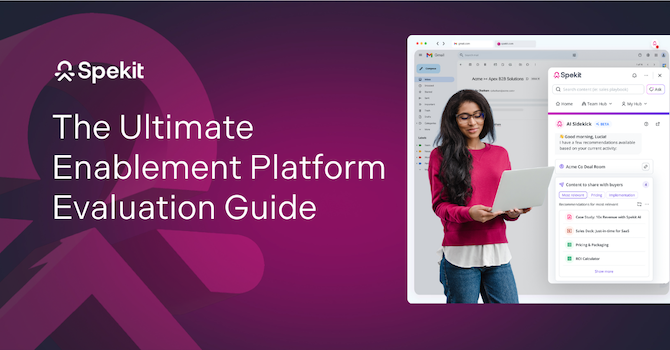Why digital sales rooms are changing how buyers buy
Deals often stall because the process is messy, not because the product is wrong.
Modern buying committees include many stakeholders. Each person researches on a different timeline. Multiple versions of the same deck circulate.
The result is confusion, delays, and inconsistent follow-up.
Digital Sales Room (DSR) software fixes this by giving buyers and sellers a single, shared workspace for every stage of the deal. It removes scattered emails, outdated attachments, and missed updates so sellers maintain control and visibility.
This guide explains what to expect from digital sales room software in 2025 and compares the top providers.
What exactly is digital sales room software
A Digital Sales Room (DSR), also called a deal room, is a shared online workspace for a specific opportunity.
Instead of juggling email threads, a DSR becomes one organized hub for every resource tied to a deal.
A strong DSR includes:
- Centralized content. Decks, proposals, contracts, and resources in one place.
- Real-time engagement tracking. Clear signals when stakeholders interact with materials.
- Structured collaboration. Comments, checklists, shared milestones, and mutual action plans to keep everyone aligned.
Use a DSR to coordinate complex B2B deals, align distributed decision makers, and keep timelines on track.
What makes modern deal rooms different
Early deal rooms were static file repositories.
Modern DSRs combine content management, automation, and engagement insights to personalize each buyer experience without extra tools.
AI now plays a central role.
By understanding opportunity context such as stage, persona, industry, and past engagement, modern platforms can recommend relevant materials automatically.
The best solutions will ensure your reps move faster with precision instead of guesswork.
Six ways deal rooms & digital sales room software speeds up sales
Digital sales room software drives productivity, boosts engagement, and helps you close deals faster, no matter how complex your buyer landscape is. Here are 6 ways it helps do that:
1. Faster sales cycles
A DSR consolidates content, conversations, and contracts into one place, reducing time spent searching for information or chasing approvals. Buyers get everything they need to make decisions faster, and sellers can track progress in real time.

2. Data-driven follow-ups
Engagement analytics show which slides, documents, or proposals buyers view most. Reps can tailor follow-ups to match those interests, leading to higher conversion rates.

3. Higher buyer engagement
Comments, acknowledgments, checklists, and milestones keep work moving. Stakeholders can contribute on their schedule.
4. Less back and forth
Version control and instant notifications replace long email chains. Everyone works from the latest file.
5. Live deal health
Dashboards show who viewed what and when. Reps use those signals to act at the right moment and maintain momentum.
6. Cross-functional alignment
Sales, marketing, and legal work in one workspace. Handoffs are clear and messaging stays consistent.
Why digital sales rooms outshine traditional sales tools
When deals get complex, traditional tools introduce friction:
- Reps drop links instead of guiding the process.
- Content is not mapped to stage or stakeholder.
- Buyers receive too many files and no clear next step.
CRMs, email threads, and generic file-sharing tools were not built to deliver a structured, personalized buying experience. Digital sales rooms are.
The table below shows why traditional solutions are no longer sufficient in today’s sales environment.
Eight essential features of a great digital sales room software
From a centralized content repository to AI capabilities, here are eight features to look for in a digital sales room:
- Collaboration tools: Your DSR should have built-in chat, commenting, or Q&A that keeps everyone, buyers and sellers, on the same page. This reduces messy email threads and ensures no critical question slips through the cracks.
- Secure access and permissions: Seek out role-based access, encryption, and audit trails to protect sensitive deal information. Buyers feel more comfortable sharing data when trust and confidentiality are guaranteed, accelerating the sales process.
- CRM integrations: Your DSR should connect with Salesforce, HubSpot, or your preferred CRM, so reps don’t have to bounce between multiple dashboards. The less time they spend on manual data entry, the more time they have to sell.
- Personalization and branding: Your DSR should let you customize the look and feel, company colors, logos, and layouts, to keep the buyer experience consistent and professional. A branded workspace boosts credibility and makes your proposals instantly recognizable.
- AI/automation capabilities: Your DSR should leverage AI to proactively surfaces the best-performing, most relevant content for each buyer scenario, based on context like email threads, call transcripts, calendar events, and Salesforce opportunities.
- Scalability and user-friendly setup: Ensure the solution can handle your team’s growth and has an intuitive interface for quick onboarding. A flexible, easy-to-use DSR gets everyone up to speed faster and positions new hires to contribute right away.
10 best digital sales rooms to choose from
1. şÚÁĎłÔąĎÍřĚýDeal Rooms - Personalized buyer experiences in the flow of work
şÚÁĎłÔąĎÍř Deal Rooms are designed for modern enablement teams that want to create guided, personalized buyer experiences directly from their existing workflows.
Instead of requiring reps to log into a separate platform, şÚÁĎłÔąĎÍř surfaces Deal Rooms into the tools sellers already use, like Salesforce, Gmail, Outlook, or Chrome, turning content and collaboration into a seamless, measurable workflow.
1. Context-aware content recommendations: şÚÁĎłÔąĎÍř’s AI Sidekick analyzes context from CRM data, call notes, and engagement signals to suggest the most relevant sales materials for each buyer. Reps no longer search through folders or ask managers for the “right deck” — Sidekick brings the answers to them.
2. AI-powered personalization and branding: From auto-generating executive summaries to refining tone, reformatting slides, or tailoring messaging, şÚÁĎłÔąĎÍř helps reps customize Deal Rooms in seconds, without rewriting from scratch. Speed + polish = more personalized buyer experiences, less manual work.
3. Real-time content sync: Deal Rooms stay automatically up to date by syncing with Google Drive, SharePoint, and Confluence. When a file is updated, the latest version is instantly available in the room, keeping buyers aligned with accurate, trusted information.
4. Buyer engagement insights: şÚÁĎłÔąĎÍř's DSRs go beyond analytics to deliver real, actionable insight. The dashboards show exactly what content is resonating, who’s engaging, and what’s influencing pipeline so reps, enablement, and leaders can all act on what’s working.
5. Connected across the enablement layer: şÚÁĎłÔąĎÍř’s Deal Rooms are powered by the same AI and content governance engine that drives its broader enablement platform. This means reps can move from content to enablement to buyer delivery in one motion, with every action tracked and measurable.
Success story: Q4 Inc. reclaims 4,000+ hours quarterly & 3Ă— ROI with şÚÁĎłÔąĎÍř Deal Rooms and AI Sidekick
Before adopting şÚÁĎłÔąĎÍř, Q4’s sales team struggled with content fragmentation and inconsistent onboarding. Reps often searched across multiple systems for sales materials, while enablement leaders spent hours manually managing updates and reinforcing training. With şÚÁĎłÔąĎÍř embedded directly into Salesforce and Chrome, Q4 unified its enablement and content strategy. Sellers now access the right materials, competitive insights, and process guidance in real time without breaking their workflow.
With şÚÁĎłÔąĎÍř Deal Rooms layered on top of this foundation, Q4 now delivers personalized buyer experiences, monitors content performance, and directly links enablement to revenue impact.
"The deal rooms are taking off like wildfire! It's going to be exactly as I thought, the number one method of communication to clients." - , Head of Revenue Enablement and Training at
In less than a year they've seen:
- ‍3x return on investment, thanks to a massive boost in usage and productivity‍
- 23x growth in usage and engagement‍
- 30% fewer ad-hoc questions to managers
As Q4’s Revenue Enablement leader shared, şÚÁĎłÔąĎÍř became “a single source of truth for everything our reps need to succeed, accessible right where they’re working.”
"We at Q4 think that the Deal Rooms are a fantastic feature. We're launching a new internal initiative for our clients and it provides a wonderful and convenient medium for us to consolidate necessary information into a client-branded packet. Once I got the workflow going, I was able to create each branded Deal Room in under one minute, including custom branding. Great idea and implementation! From here, we can track which sections of the Deal Room the client has viewed and for how long. This provides us with valuable data on how we can improve and consolidate the delivery of information on our end to ensure future clients are supplied with as much detail as possible and mitigate how much is missed on average." - Mitch, Events Manager at Q4 Inc
Best for: Enablement and revenue teams that want an AI-powered deal rooms embedded in daily workflows, with content governance and analytics connected to revenue impact.
Pricing: Available on request. Request a demo.Ěý
şÚÁĎłÔąĎÍř’s DSR helps reps:
- Curate content by stage and persona.
- Personalize materials for each stakeholder.
- Track buyer intent through views and time spent.
- Close the loop between marketing, sales, and enablement.
Request a demo to see how şÚÁĎłÔąĎÍř it works.
2. AccordĚý
Best for: Mutual action plans and milestone tracking.

Accord focuses on building mutual action plans and shared milestones for consultative sales. Its digital sales room helps align sellers and buyers around tasks, timelines, and next steps. However, most of the experience is process-driven rather than content-driven. Reps still manage files manually, and personalization depends on templates rather than AI recommendations or dynamic insights within their workflow.
Key features
- Shared roadmap. Align on objectives, milestones, timelines, and next steps to keep buyers engaged and accountable.
- Buyer collaboration tools. Users can share feedback, ask questions, and exchange updates in one place, cutting down on back-and-forth emails.
- Deal signals. Gain a crystal-clear view of each deal’s status through defined execution criteria synced directly to your CRM.
G2 Review

Pricing: Accord offers a free plan. Paid plans start at $99 per user/month. There’s .Ěý
3. GetAcceptĚý
Best for: Document creation, signatures, and basic engagement tracking.
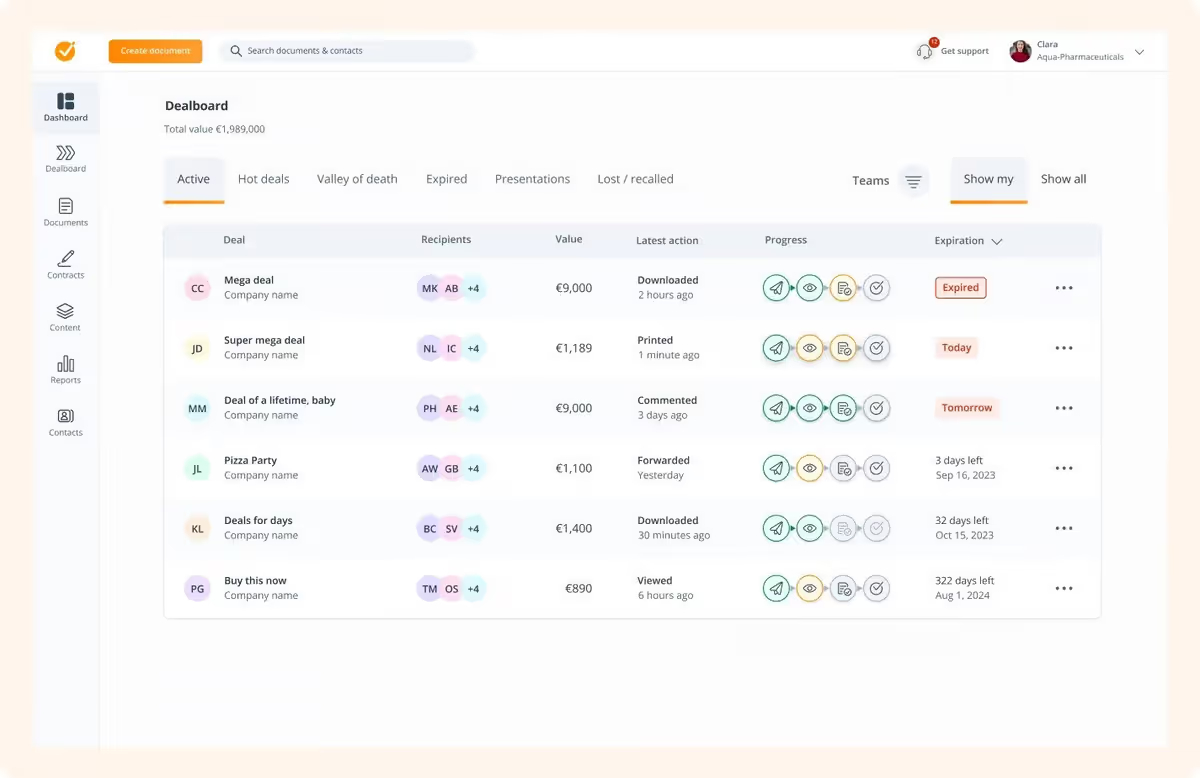
GetAccept blends document management, proposal creation, and e-signature workflows in one digital sales room platform. It streamlines approvals and signatures but provides limited intelligence around enablement or content effectiveness. Buyer engagement is captured at the document level, and sellers still toggle between tools to curate and personalize materials.
Key featuresĚý
- Proposal creation. Build, edit, and send tailor-made proposals using ready-made templates.
- Real-time engagement insights. Track precisely when and how prospects interact with your proposals, so you can make timely follow-ups.
- E-signatures. Capture secure, globally compliant e-signatures to reduce friction for your buyers and streamline the entire closing process.
- Contract management. Store all contracts in one place, set renewal reminders, and maintain visibility on document status.
G2 Review

±Ę°ůľ±ł¦ľ±˛Ô˛µĚý: GetAccept offers a free trial. Paid plans start at $25 per user/month. There’s a .Ěý
4. DockĚý
Best for: Nicely designed buyer pages and checklists.
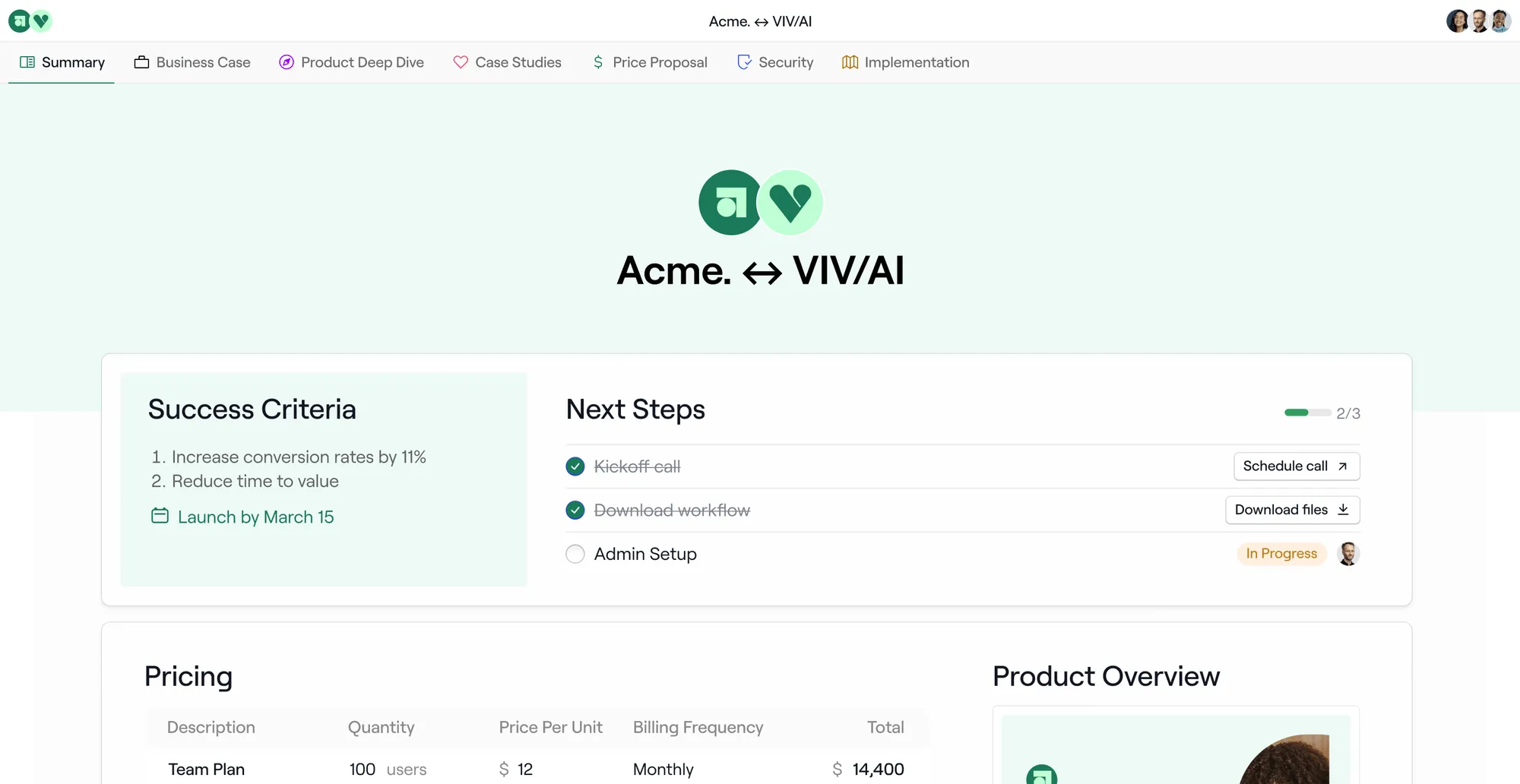
offers visually branded workspaces with mutual action plans and content organization. Its digital sales rooms help create polished buyer experiences and clear next steps. Still, customization and setup are largely manual, and real-time intelligence or in-workflow recommendations are minimal. Most collaboration occurs after content is shared, not while reps are working.
Key featuresĚý
- Custom branding and design. Customize workspaces with your company colors, logos, banners, and even custom domains to deliver a consistent, professional brand experience that builds credibility with buyers.
- Mutual Action Plans. Guide buyers through complex evaluation stages with clear timelines and accountability, helping champions navigate security reviews and internal approvals.
- Analytics. Track stakeholder engagement and buyer activity to identify deals with momentum, improve forecasting accuracy, and connect enablement efforts directly to revenue outcomes.
G2 Review
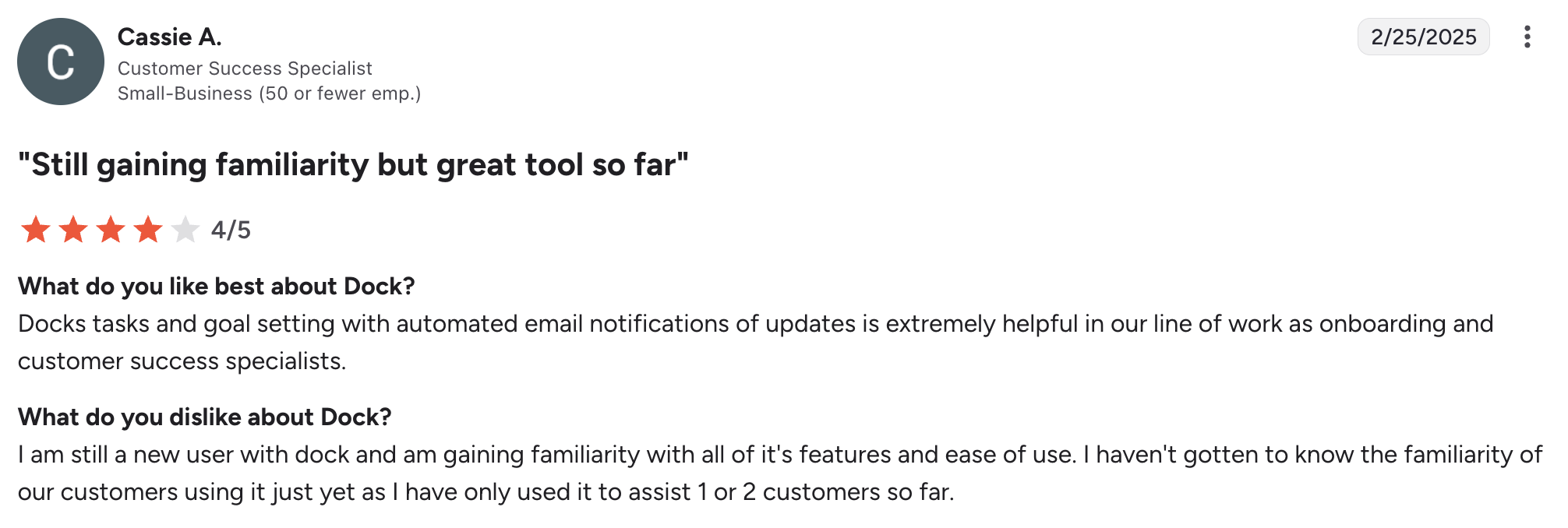
Pricing: Dock offers a free plan. Paid plans start at $350/month (for five users). There’s a .
Related read: 18 Best AI Sales Tools to Use in 2025
5. AlignedĚý
Best for: Simple deal rooms that centralize links and tasks.
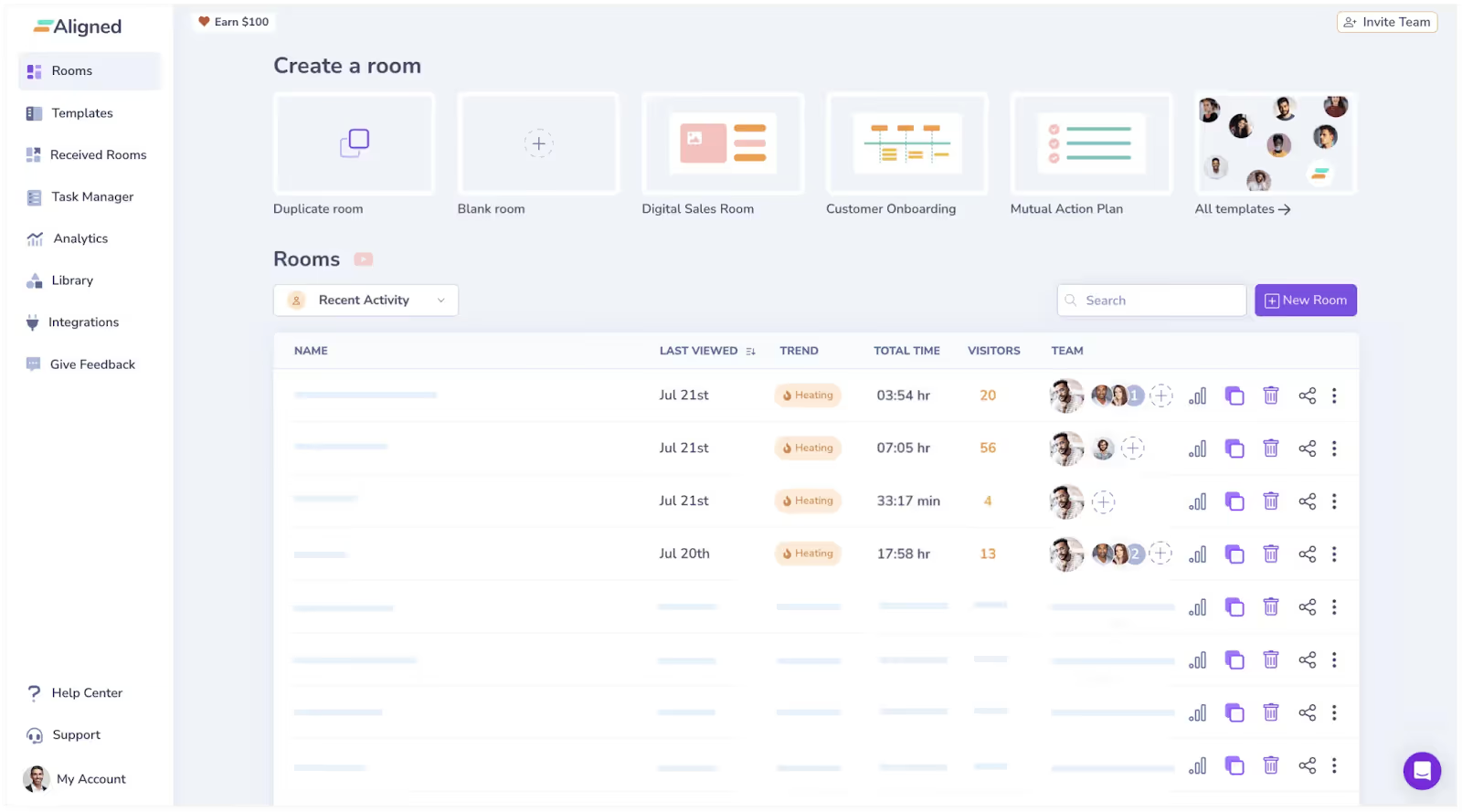
Aligned provides a collaborative digital sales room that centralizes files, tasks, and updates between buyers and sellers. It’s built for shared visibility and accountability but relies on static content uploads. The platform lacks automation or governed content management, so accuracy and personalization depend on manual effort and version control.
Key featuresĚý
- Stakeholder collaboration. Bring internal teams and buyers together to manage action items, files, and discussions in a single, accessible space.
- Buyer interaction insights. Monitor activity and comments, receive real-time alerts on deal-room interactions, and use these signals to adjust your strategy before deals go cold.
- White label customization. Impress prospects with a branded environment featuring your logo, banner, and URL.
G2 Review

Pricing: Aligned offers a free plan. Paid plans start at $29 per seat/month. There’s a custom Enterprise plan.Ěý
6. Allego
Best for: Coaching workflows and mobile learning.
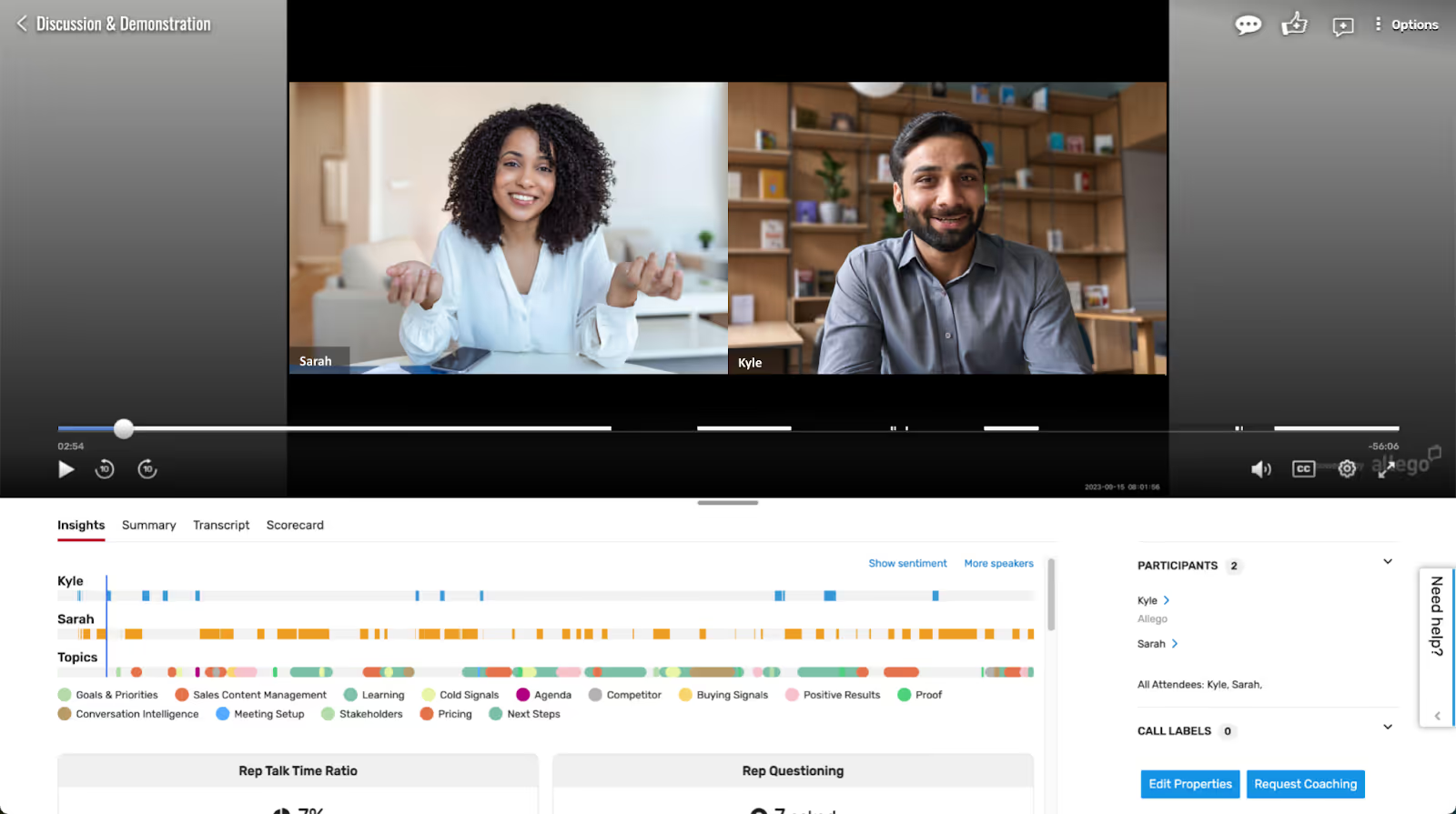
Allego is a sales enablement software that integrates content management, training, and video coaching into a single platform. Its digital sales rooms extend this to buyers, allowing shared access to presentations and learning materials. While robust for internal enablement, the buyer experience is less contextual, requiring reps to curate and share assets outside their primary workflow.
Key features
- Content management. Sync and maintain your collateral in one place so reps can easily locate and share relevant materials, internally or externally.
- Training and product rollouts. Introduce new products, messaging, or processes with virtual courses, interactive learning modules, and reinforcement exercises to keep sales reps informed.
- Security controls. Restrict or grant access to specific content for each stakeholder, ensuring sensitive information remains protected.
- Real-time buyer engagement tracking. Receive immediate notifications whenever a stakeholder engages with your sales room content, so you can time follow-ups perfectly.
G2 Review

Pricing: Available on request. .
Read: 16+ Top Sales CMS Platforms
7. TrumpetĚý
Best for: Fast, branded pages after demos.
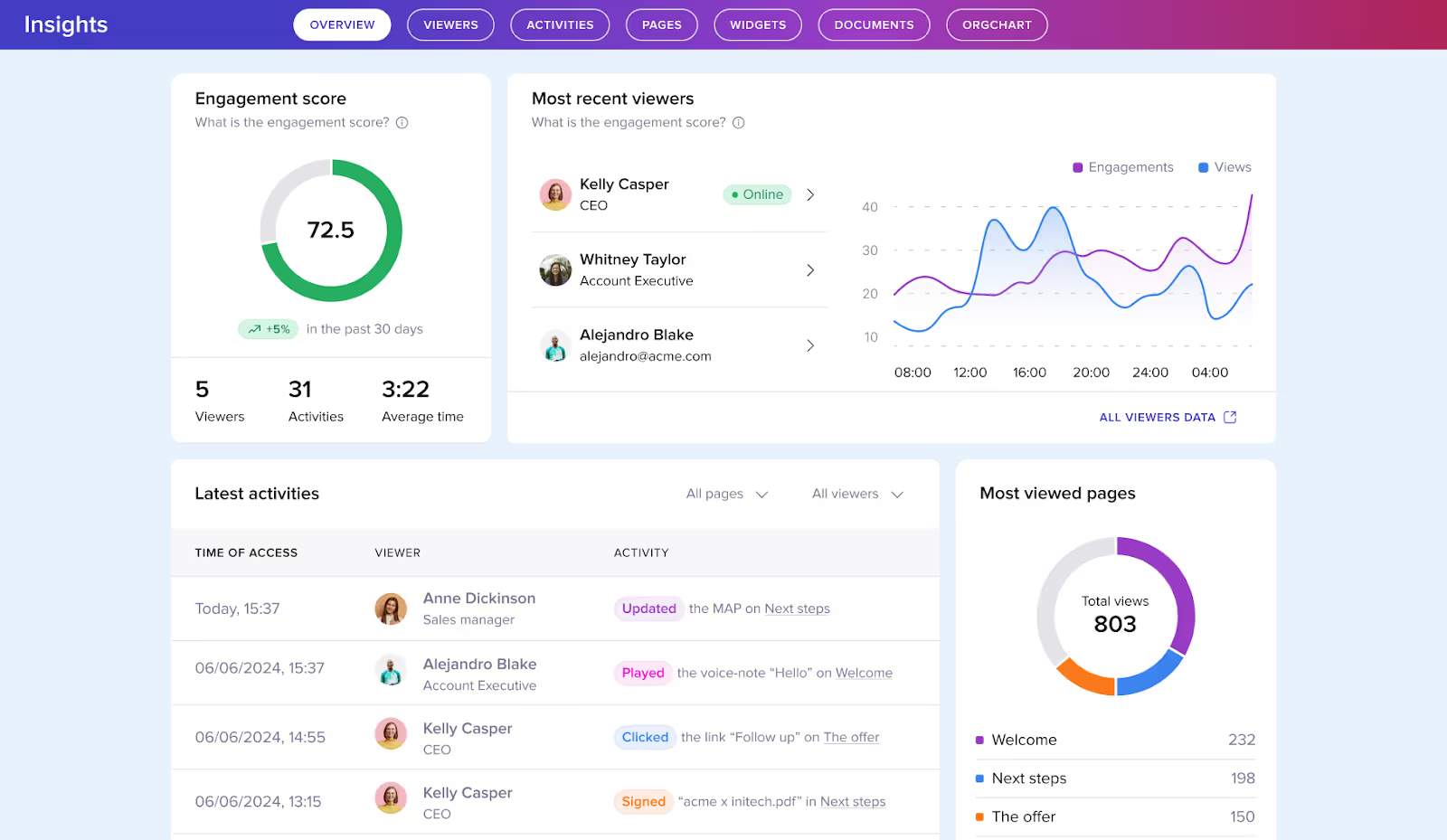
Trumpet simplifies follow-up by turning deals into branded microsites (“Pods”) that compile videos, proposals, and guides under one link. It offers strong visual appeal and quick setup but limited automation or analytics depth. AI personalization and governed content delivery are still developing, leaving reps to manually manage updates and insights.
Key features
- Centralized content library. Organize demo recordings, proposals, and product guides in neat, stackable folders so everything is readily available under one link.
- Custom branding and design. Personalize Pods with fonts, logos, and backgrounds that match either your brand or your buyer’s brand.
- Stakeholder data tracking – Get notified when a new person joins a Pod and let Trumpet automatically enrich your CRM with their details.Ěý
G2 Review

ĚýPricing: Trumpet offers a free plan. Paid plans start at ÂŁ36 per user/month.
8. SeismicĚý
Best for: Large enterprises needing extensive analytics and customization across global teams.
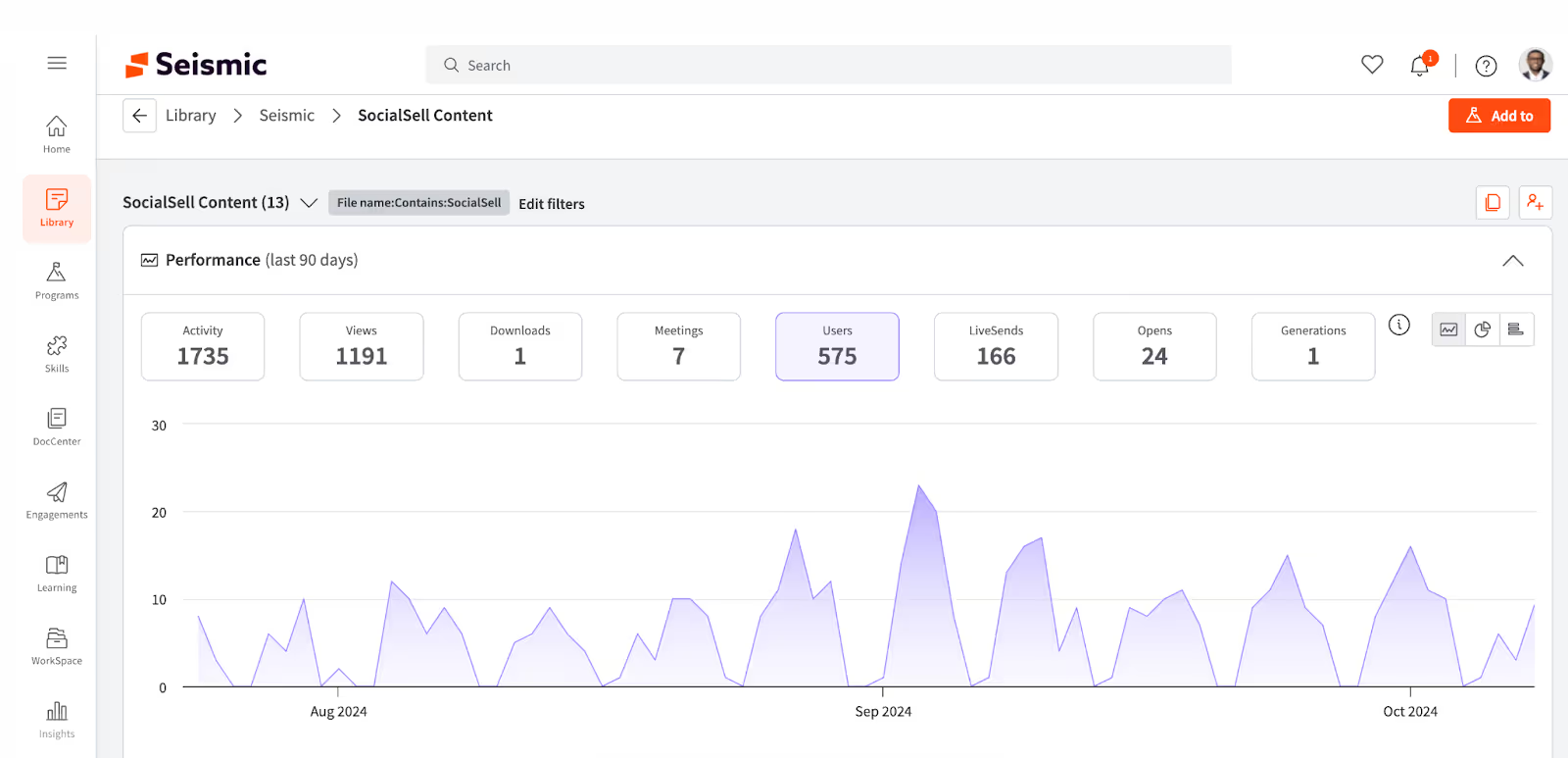
Seismic combines enablement, learning, and sales content management. Its digital sales room adds buyer-facing collaboration for large teams. However, the platform’s complexity and administrative overhead make adoption slower, and in-workflow delivery requires multiple configurations and integrations.
Key featuresĚý
- Sales content management. Search helps reps locate, tailor, and share sales collateral, while automated workflows handle mass content production and governance.
- Sales learning. Create interactive training courses with role-plays and video recordings, and use AI-driven coaching plans to pinpoint skill gaps for targeted improvement.Ěý
- Personalized deal rooms. Customize the room’s layout, branding, and messaging with a drag-and-drop editor, and record quick video intros for a more personal buyer experience.Ěý
- DSR templates. Standardize branding and content so that reps can launch best-in-class deal rooms quickly and consistently.Ěý
G2 Review

Pricing: Available on request. .
9. DealHubĚý
Best for: Businesses that want a configurable CPQ solution seamlessly integrated with their CRM.

DealHub unifies CPQ, CLM, and billing with a digital DealRoom for quotes and approvals. It enables structured pricing conversations and faster contract workflows. The focus remains on quote-to-cash rather than guided enablement, so content relevance, personalization, and buyer engagement insights are limited to the deal documentation level.
Key features
- Guided quote configuration. Use intuitive guided selling, smart filters, and structured product catalogs to produce faster, more accurate quotes.
- Quote generation. Easily generate quotes for new business, renewals, expansions, or amendments, ensuring consistent, compliant pricing every time.
- Contract creation. Build NDAs, MSAs, and other agreements with flexible templates and a clause library to maintain compliance and consistency across your organization.
- Branded sales rooms. Customize your DealRoom’s branding, content layout, and workflows to deliver a cohesive, personalized buyer experience.
- Real-time buyer intent. Track buyer engagement through live updates in email or Slack, letting you jump in with the right message at the right time.
G2 Review

Pricing: Available on request. .
Read: 27+ Best CPQ Software & Tools
10. FlowlaĚý
Best for: Teams seeking a low-code, user-friendly DSR that’s easy to adopt and maintain.

Flowla provides a lightweight, low-code digital sales room that combines content, steps, and e-signatures in a single shareable flow. It’s simple to launch and easy to adopt for smaller teams but lacks advanced governance, analytics, or AI-driven recommendations. Personalization relies on manual setup instead of contextual automation.
Key features
- Mutual Action Plans. Turn complex sales processes into one collaborative, actionable flow by setting deadlines, assigning tasks, and tracking progress at a glance.
- Content management. Organize your entire sales collateral, from pitch decks to video testimonials—, n a dynamic library that updates every flow automatically and offers insights on performance.
- Flowla AutoPilot. Automate the creation, delivery, and management of personalized sales room links that sync seamlessly with your CRM. AutoPilot also automates follow-ups and task reminders.
- E-signatures. Allow clients to sign documents directly within your flows, with built-in email verification to increase security and simplify the signing process.
- Revenue intelligence. Capture real-time engagement data, from link clicks to device details, so you can spot hidden decision-makers, identify bottlenecks, and optimize your sales process effectively.Ěý
G2 Review

Pricing: Flowla has a free plan. Paid plans start at $49 per seat/month. There’s a . Ěý
The future of Digital Sales Rooms: Agents, automation, and anticipation
The next generation of digital sales rooms won’t just organize deals, they’ll manage them.
AI is reshaping how revenue teams work, moving from manual sharing and static dashboards to intelligent, automated workflows that anticipate what sellers and buyers need next.
That evolution is already underway.
At şÚÁĎłÔąĎÍř, we’re building deal rooms that do more than centralize content. They think, act, and adapt in real time.
Intelligent agents
Soon, AI agents will take on the operational work behind every deal room, tracking activity, surfacing the next best actions, and even preparing tailored follow-up content before a rep asks. These agents will act as true partners in execution, not just assistants.
Automations that connect enablement to revenue
Every interaction inside a şÚÁĎłÔąĎÍř Deal Room will soon trigger intelligent workflows, updating CRM records, alerting reps when a buyer engages, and recommending the right content or step based on deal stage and behavior.
This means less toggling between tools and more time driving revenue.
Personalized buyer experiences at scale
As agents and automations work together, every deal room will evolve into a living, adaptive workspace. Reps will deliver personalized, data-informed experiences at scale while maintaining full content governance and brand consistency.
The vision ahead: enablement that anticipates, not reacts.
A single platform where AI connects knowledge, execution, and measurement, turning every rep into a top performer and every buyer interaction into measurable impact.
şÚÁĎłÔąĎÍř is building the future of just-in-time enablement, where deal rooms don’t just organize your process; they power it.
See how you can get started. Request a demo today.

